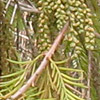Taxodium distichum (L.) Rich (bald cypress, southern-cypress, white-cypress, tidewater red-cypress, Gulf-cypress, red-cypress, swamp cypress) is a member of the Cupressaceae family. In the past it was included in the Taxodiaceae family, which was later included as a sub-family of the Cupressaceae. Bald cypress is a medium-large coniferous tree with a pyramidal crown when young and a broad crown when mature. The branches bend downwards and impart it with a weeping crown, which develops in humid and warm places.
Bald cypress originates in the eastern Unites States, where it grows in marshes along the Atlantic coast and the Gulf of Mexico from Delaware to Texas. It penetrates into the mainland along rivers in the Mississippi Valley. It grows mainly in areas that are flooded the year round, and is therefore also called “swamp cypress”. Here it reduces the water flow and the erosion. Drying of the marshes exposes it to the danger of fires, which harm the trees and the seedlings and result in its substitution with other plants such as poplars and willows.
Nutria (river rats), that gnaw plants in humid habitats, are an invasive species also in the bald cypress’s habitat. They gnaw and uproot its young seedlings and impair the renewal of forests in the area.
Bald cypress is unique among the coniferous trees in that it sheds its leaves in the winter, where the leaves turn green-yellow. It is conspicuous in small pinnate branches with two rows of acuminate leaves which are 1-2 cm long and 1-2 mm broad. The fact that the tree sheds its leaves in the winter has given it the common English name “bald cypress”.
Bald cypress is a monoecious plant with unisexual flowers. The elongated and loose male cones and the rounded female cones are carried on separate branches on the same tree. The young female cones are green, and turn brown-gray in their mature stage. They are globular and resemble those of the cypress and have a diameter of 2.5-3.0 cm. The seeds are the largest of the Cupressaceae family. They serve as a food source for squirrels, water fowl and other birds.
The bark of bald cypress is not thick (2.5-3 cm), with a brown to gray-red color. When it grows in marshes, the tree develops “knees” at the base of the trunk, which serve as crutches that stabilize it above the water surface and above the soft soil. In the past it was thought that these are structures that assist the plant in respiration. Another trait that is unique to the bald cypress among coniferous trees is that it develops root shoots after felling, but these usually do not develop into nice trees.
Bald cypress is a long-living tree and usually reaches a height of 30-40 m and a diameter of 2-3 m. The tallest individual is found in Virginia, with a height of 44 m. The oldest tree with the broadest trunk grows in Louisiana, and its diameter at breast height is 5.21 m. The oldest tree is aged over 1,600 years. Bald cypress grows slowly in humid and warm habitats and with time achieves large amounts of wood, with a peak yield of 1000 cubic meters per ha. Its hard wood is not fragrant and is water-resistant. These properties have led to the planting of this tree in water bodies for wood production. Its water-resistance has made its wood suitable for the production of shingles, for the coating of boats and buildings, in addition to its uses as wood for furniture and construction. In the Unites States there are known cultivars that are used for planting.
Bald cypress is the national tree of the State of Missouri in the southern US. In Israel it was planted in the past in public parks, in private gardens and along water bodies in the plains and valleys. Today its use in gardening has decreased, due to its high water consumption. Especially large bald cypress trees in Israel are found at the springs of the Yarkon River, at Pas HaYerek in Kiryat Haim, at the Ilanot acclimatization park and in many public parks.
Written by Zvi Avni





